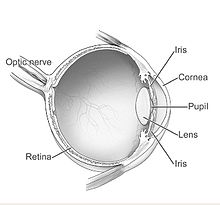Post-mortem chemistry
Biochemical analyses of vitreous humor, cerebrospinal fluid, blood and urine is important in determining the cause of death or in elucidating forensic cases.
Because of its location and the inert nature of the vitreous humor, it is resistant to some of the post-mortem changes that occur in the rest of the body.
The viscosity of the vitreous humour will be increased after time of death due to water escaping.
The vitreous humor contains various electrolytes, including but not limited to sodium, potassium, chlorine, calcium, and magnesium.
The concentrations of these electrolytes can be measured with analyzers and related to the time since death with various equations.
There are various substances in the cerebrospinal fluid that can be measured including urea, glucose, potassium, chloride, sodium, protein, creatinine, calcium, alkaline phosphatase, and cortisol.
Sodium and Potassium can also be measured in the cerebrospinal fluid to predict the time since death,[5] but it is not as accurate as it would be if the vitreous humor was used, since it has a lower correlation.
The samples are usually put through various tests, but the most common instrument used to quantify and determine a substance is gas chromatography-mass spectrometry (GC-MS).
The results of post-mortem toxicology testing are interpreted alongside the victim's history, a thorough investigation of the scene, and autopsy and ancillary study findings to determine the manner of death.
The contents can also be analyzed for drugs or poisons to help determine a cause of death if it is unknown.
Endocrine disorders can be diagnosed by looking at hormone concentrations and epinephrine and insulin levels.
Blood pH and concentrations of several chemicals are tested in a corpse to help determine the time of death of the victim, also known as the post-mortem interval.
[10] The decrease in the concentration of oxygen because of the lack of circulation causes a dramatic switch from aerobic to anaerobic metabolism [10] This type of analysis can be used to help diagnose various different types of deaths such as: drowning, anaphylactic shock, hypothermia or any deaths related to alcohol or diabetes.
Although these types of diagnosis become very difficult because of the changes to the body and biochemical measurements vary after death.
